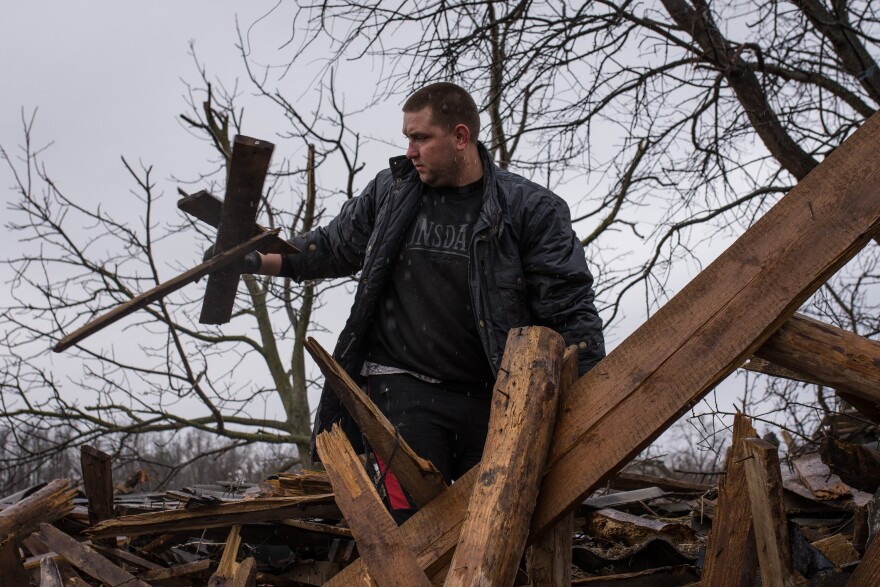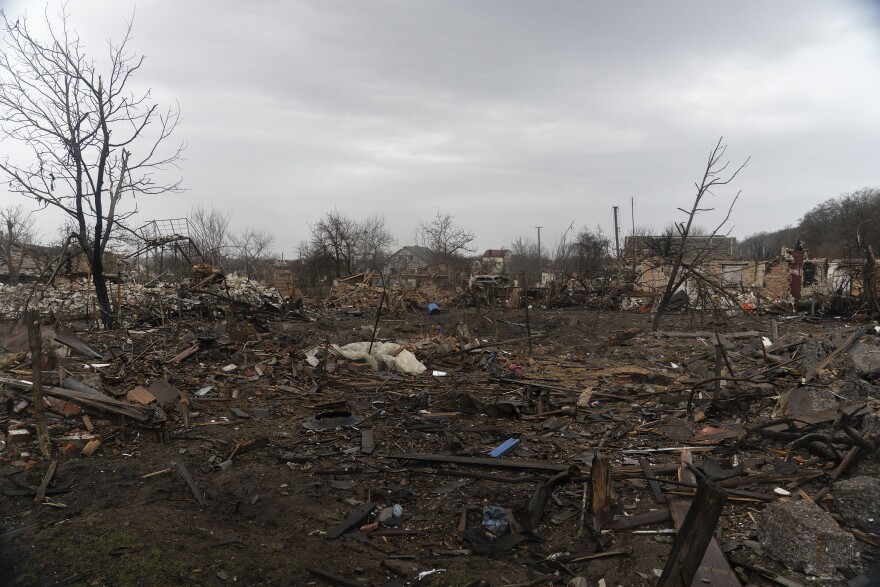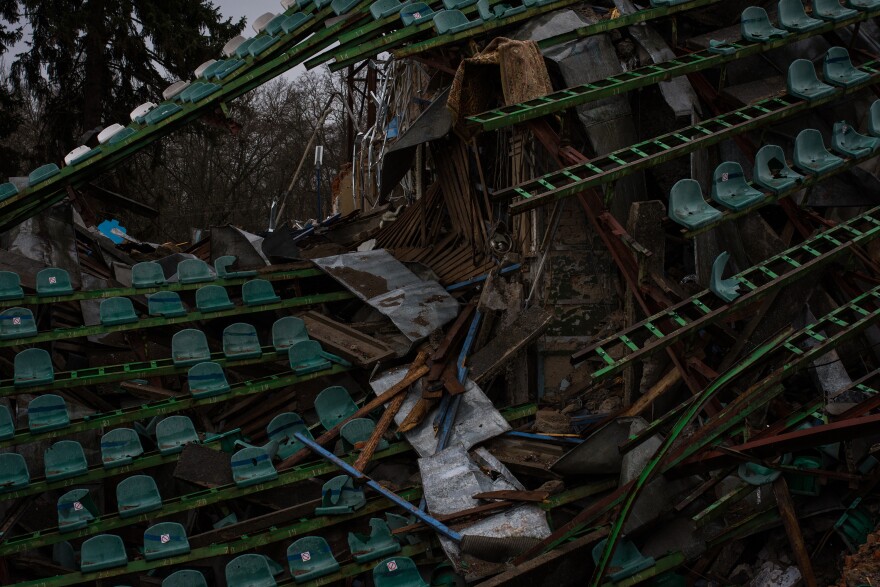CHERNIHIV, Ukraine — On a cold and rainy Saturday, Ivan Mekshun and his brother, Volodymyr, were digging through a heap of wood and metal debris that, a month ago, had been their home and livelihood.
"I don't know what to say. Everything is damaged," Ivan Mekshun said, shrugging as he tossed away board after board.
The Mekshun brothers had the bad fortune of living outside of Chernihiv, the northeastern Ukrainian city that was besieged by Russian forces for a month before they abruptly withdrew in early April.
For weeks, the city was bombarded daily. More than 200 people died, officials say, and hundreds more were wounded. Villages on the outskirts of town, like the Mekshuns' home of Novoselivka, were reduced to rubble.
The Mekshuns had evacuated to a nearby village when the Russians rolled in. They came back last week to find their house and garage ruined.
Their only source of income, they said, was running a small-time auto repair business out of their garage. They had returned to look for tools and supplies, anything they could salvage.
"We'll try to find some of our things, then maybe we'll build something else. What else can we do?" Ivan said.

Now, as Ukraine and Russia both prepare for a fiercer fight in eastern Ukraine, analysts warn that Russia could increasingly turn to the kind of siege tactics used in Chernihiv that inflicted disproportionate harm on civilian infrastructure.
Chernihiv is to the northeast of Kyiv, about 55 miles from the Russian border and even closer to Belarus. Russian forces reached the city soon after the invasion began on Feb. 24 and quickly moved to encircle it. By the fourth day of the war, the Pentagon was warning of "siege tactics."
Residents described living for weeks in their basements, with no heat or running water. Food was hard to come by. Evacuation routes grew more perilous by the day; eventually, every bridge leading out of town was destroyed.
And always present, they said, was the risk of a sudden airstrike or round of shelling.

Denis Yaroshenko, a truck driver-turned-volunteer, said he was driving through town when a round of shelling began, sending him swerving through the streets. "I saw trees falling, power lines dropping," he said.
He said he watched a shell blow off a woman's leg. Yaroshenko held out a piece of shrapnel as large as his hand. "Look how sharp this is," he said.
One of the city's oldest churches, St. Catherine's Cathedral, was damaged in a rocket attack last month, the priest said.
"They hit the church just before mass," said Father Mykolai, who showed his own pieces of shrapnel, collected from among the broken cobblestones outside. Ukrainian soldiers were guarding a crossroads nearby, but the attack did not hurt them. "They said the church saved them," he said.
Ukrainian officials have accused Russia of purposefully making civilians suffer in order to increase leverage in diplomatic negotiations. In cutting off Chernihiv from the capital of Kyiv, the Russians had "turned its inhabitants into hostages," said Lyudmila Denisova, Ukraine's human rights ombudsman, in comments last month.
The single deadliest strike came just after noon on March 3, officials say. A Russian aircraft flew over central Chernihiv, dropping at least eight bombs on an area with several apartment buildings, a pharmacy and a hospital. Ukrainian officials say there were no military targets in the area.
Forty-seven people were killed, according to local officials. Amnesty International later said the strike "may constitute a war crime."
"People saw the aircraft flying at a very low altitude, something like 300, 400, 500 meters maximum. And there was not one cloud in the sky. The sun was shining brightly," said Chernihiv Mayor Vladyslav Atroshenko, who added that the pilot would have had a clear view of what he was striking.
"It's not some mistake. It's not just by chance," Atroshenko said.
One month after the strike, the damage is still obvious, with massive chunks missing from buildings. In places, the blasts shook outer walls clean off, revealing the apartments inside. Rubble and burned-out cars litter the ground below.

A few hundred yards away, resident Nina Kotyar said she was sheltering in her building's basement when the strike happened. "We're lucky we went down in time," she said. The force of the blast blew out her building's windows. Even in the basement, she said, bits of brick and cement fell on her.
Her sister-in-law Lyudmila Kotyar was at her home about a mile away. When she heard the noise and saw the smoke, she started running toward Nina's building — without cellular connection, there was no other way to know whether she had survived.
"It was very, very scary," Lyudmila said, her voice shaking as she recalled the strike. "I was very worried for her."
"She ran and started to hug and kiss me, saying 'You're alive!' " said Nina. "She ran under the bombs to check if we were alive."

In recent weeks, the Kremlin has ramped up its false narrative that Russia is fighting against fascism and Nazism in Ukraine. That could be an attempt to prepare the Russian public "to accept further Russian atrocities in Ukraine and harsher crackdowns on civilian populations in Russian-occupied parts of Ukraine," wrote the Institute for the Study of War, a research group based in Washington, D.C.
In Chernihiv, the siege appears to be over. Russian troops have withdrawn from the region entirely, the Pentagon said last week. The airstrikes seem to have stopped.
But lives are still disrupted.
"We're still living in the basement, because all the windows are broken upstairs. There's wind blowing in. You can't really live there," said Nina.
Her 85-year-old mother, who has difficulty walking, lives with her. They are trying to find a way out of Chernihiv, perhaps to meet a daughter who lives in Amsterdam. But limited routes out of the city, along with her mother's mobility issues, have made a departure difficult to plan, Nina said.
"To be honest, we are fed up with life in the basement. Excuse me for these details, but we haven't washed ourselves for a month and a half," she said. "That's probably the worst part."
But things are good now, Nina and Lyudmila say. They can go outside when the weather allows — inexpressibly better than sheltering from airstrikes.
"The trees are going to bloom soon, and everything's going to be all right," she said.
Additional reporting by NPR's Nathan Rott, Iryna Matviyishyn and Luka Oleksyshyn in Chernihiv.
Copyright 2023 NPR. To see more, visit https://www.npr.org.



